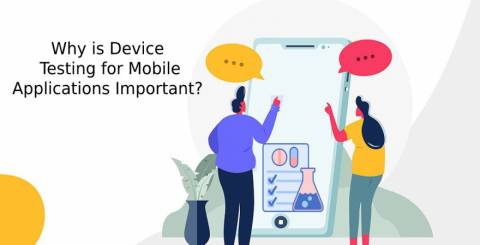What Is the Strategy Used to Test New Mobile App?

When operating a company nowadays, one of the most important objectives is to offer the greatest possible experience for every prospective client at all times. Because of this, you devote many hours to verifying that the product or service meets all of your requirements or that the website is user-friendly and up-to-date. Because of the abundance of mobile device testing services and mobile apps available nowadays, any faults in a product may be discovered fast and do significant harm to the product's success. Mobile app developers are fully aware of how critical it is to conduct actual mobile device testing or to create a proper mobile testing strategy to provide a high-quality solution to their clients.
Why is Device Testing for Mobile Applications Important?
An app's functionality must be flawless. The same attention that was taken into developing the idea and establishing the company should be used for testing and quality assurance for mobile devices. Performing this kind of testing in-house is not a practical option. It is necessary to conduct expert testing to detect any problems in advance.
Most mobile apps are deleted and abandoned when users experience even the most minor irritating issues, which might have been prevented with proper testing. This is true regardless of how much work is put into the design and testing of mobile applications. Glitches and app bugs, on the other hand, are not life-threatening diseases. They come within the category of readily curable digital illnesses and are thus treatable.
Mobile app development services that include quality assurance testing are available to ensure that your brand and product do not become an embarrassment to you. Professional developers and testers have a broad variety of experience, abilities, and knowledge in enhancing software quality via the use of best practices.
Listed below is an online guide on mobile device testing that will assist you in developing a quality testing plan for mobile apps.
-
Quality Assurance Test Case Reviews
Great organizations recognize that quality assurance testers cannot be left in a vacuum. They must be involved in both the strategy development and the product development processes. Businesses and quality assurance experts should at the very least do a thorough evaluation of all of the test cases involved in the development of every feature. At the absolute least, this should be completed before any quality assurance analyst views the final product.
Some people believe that the QA team isn't necessary and that product managers and engineers are the ones who should be accountable for their own QA efforts. In the vast majority of cases, this extreme approach is not feasible. The QA team is critical in preventing or minimizing sources of failure before the product is released to the general public. Early on in the process, business owners and quality assurance testers should examine all of the designs, documentation, and test cases to verify that each critical flow is understood.
2. User Experience Teams must do user interface testing
UI testing is one of the most important cross-functional tasks that businesses should engage in. It's a very simple process. Designs are created and approved, and then developers, such as Android app developers, implement the designs. Finally, administrators, designers, and stakeholders, as well as quality assurance testers, come together to proofread the code to ensure that the designs and the released code are 100 percent aligned.
Organizations must establish clear processes that are based on the mobile device usability testing concept, which is a cross-functional activity in which product owners, designers, user experience architects, as well as quality assurance testers, collaborate to ensure that everything is done following the original wireframes and specifications.
3. Determine operating systems and versions support system
It's a basic, though sometimes unpleasant, fact of life that not all users are using the same operating system. The problem isn't going away, at least not soon, and as a result, it has become a commercial worry. The argument is that maintaining an excessive number of operating systems and versions may result in lower business profits. From the standpoint of quality assurance, many OS-centric aspects might go wrong.
Organization leaders should decide which operating systems to support during mobile test automation services and should evaluate the policy at least twice a year after the service is completed. In general, it is preferable to leave a few people behind than to support every operating system that is currently available. If you are unsure about which operating system and devices to support, mobile testing specialists can assist you in determining your specific needs via high-quality iOS and Android application testing services.
4. Ensure that the company's form factors are consistent
Organizational alignment across form factors is critical for the app you will support, regardless of whatever form factor it is. Even though there are many operating systems available, the number of form factors available across all smartphones is still very large.
When an app is released in foreign marketplaces, where requirements differ from one country to the next, things get much more complex. The task at hand is quite straightforward. Decide on what screen sizes and resolutions you will support on an organizational level. Work with the QA to ensure that they do a wonderful job catching all bugs.
Similar Articles
Building lending software isn’t just a technical project—it’s a business decision. Whether you're a fintech founder or part of a traditional lending institution trying to go digital, three questions will shape everything that follows
Learn why robust security is crucial for super app development. Explore key strategies and best practices for mobile app development security.
Walkie-talkies with an extensive reception capacity have changed significantly when it comes to portable communication by displaying cutting-edge features with seamless connectivity that covers more than just the state
USB-C technology has revolutionized the way we charge our devices, offering faster charging speeds, higher power delivery, and universal compatibility across multiple devices
Discover expert mobile app development strategies to create a viral app that attracts users and boosts engagement
Optimize app localization for iOS users across the EU with language, cultural, and regulatory adaptations. Engage users and boost retention with these tips!
Discover the top 10 mobile app development trends of 2024! Explore 5G, AI, AR/VR, blockchain, and more to stay ahead in the ever-evolving app development landscape.
With its triple-lens design and fantastic photo and video quality, the iPhone 11 Pro Max is extensively acknowledged for its superior camera system. But problems can occur with also one of the most advanced technologies. If you're having issues with the iPhone 11 pro max camera lens, knowing the typical problems and how to repair them
Protect your app from threats with AppSealing's robust, all-inclusive security solution. Safeguard user data, ensure compliance, and maintain top performance.









